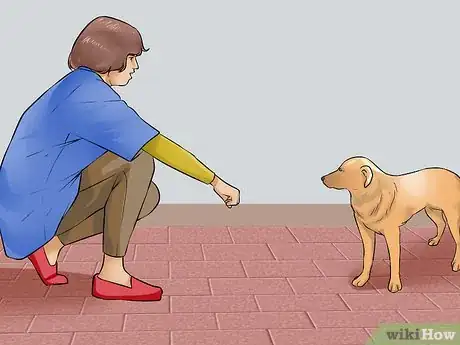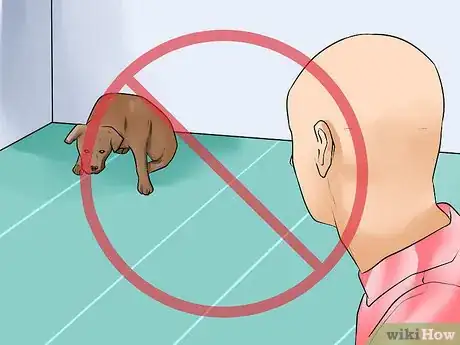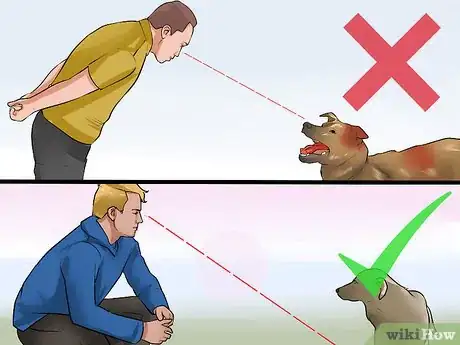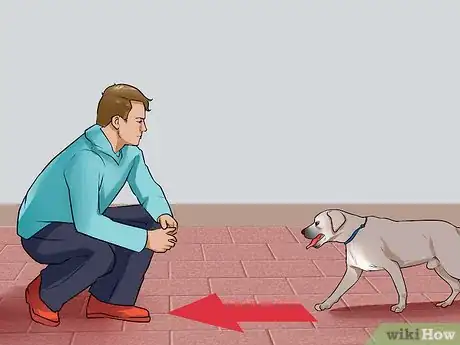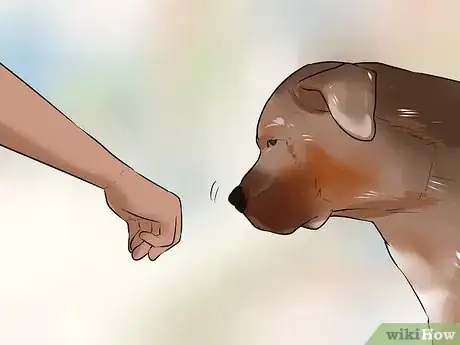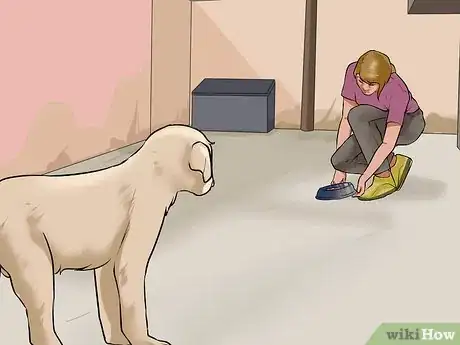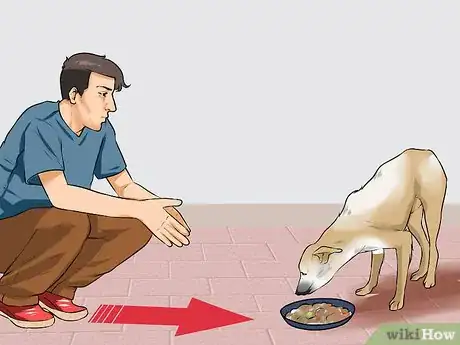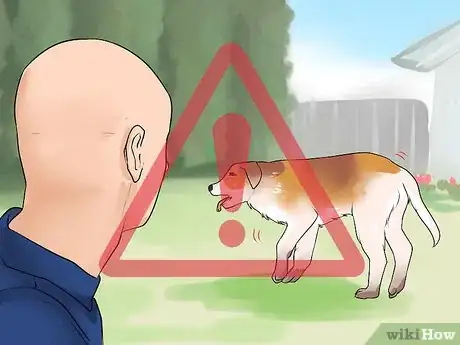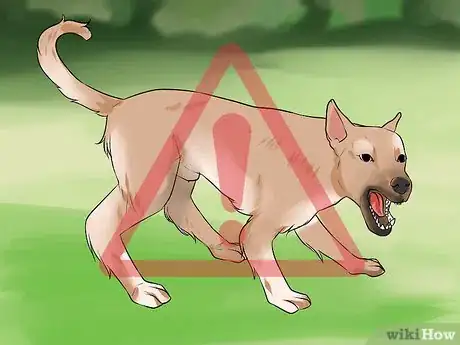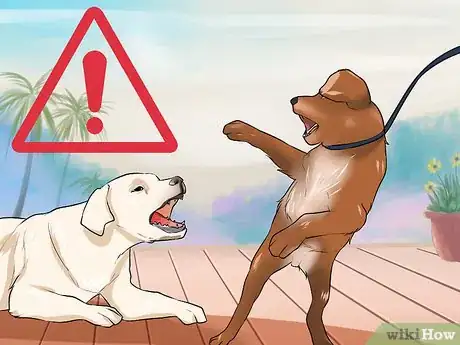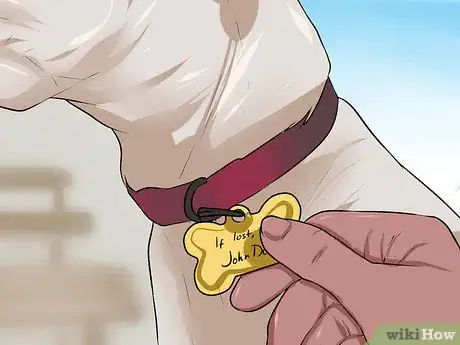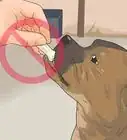This article was co-authored by Sheri Williams. Sheri Williams is a Certified Dog Trainer and Behaviorist and the Owner of sheriwilliams.com, a business that specializes in teaching veterans how to turn their dogs into service dogs or emotional support animals to assist with PTSD. Based in the Los Angeles, California metro area, Sheri has over 20 years of dog training experience and also runs a general dog training practice specializing in rehabilitating dogs through positive reinforcement training techniques. She is certified by The Animal Behavior and Training Association.
There are 7 references cited in this article, which can be found at the bottom of the page.
wikiHow marks an article as reader-approved once it receives enough positive feedback. In this case, 93% of readers who voted found the article helpful, earning it our reader-approved status.
This article has been viewed 58,306 times.
Stray dogs are often wary of humans. If you would like to help one, you first have to gain their trust. This could be a simple and quick or complicated and lengthy process depending on the pooch. The keys are patience, vigilance, and care. Find out the best methods for approaching, building trust, and dealing with strays while exercising caution to protect yourself. Regular feeding and calm, respectful behavior will go a long way towards getting a stray dog on your side.
Steps
Approaching a Stray
-
1
-
2Do not corner them. Only approach them if they are in an open area where the dog can clearly see you for your entire approach and has an easy escape route. If a dog feels cornered, they may lash out in fear.[3]Advertisement
-
3Avoid potential signs of aggression.[4] You don’t want to stare directly at the dog or make prolonged eye contact. Instead, keep your gaze directed to one side of the dog.
- It’s also good to crouch down to make yourself smaller but not to get down on your hands and knees since this puts you in a vulnerable position if the dog should attack.
-
4Let them approach you. Instead of going the whole way to the dog, stop at least 10 feet short of where they are. This allows the dog to approach you on their own initiative. Stay still and crouching while not making direct eye contact. Speak to them in a calm, friendly voice to encourage them to come.
-
5Offer your hand. If the stray shows interest by moving towards you, slowly put your hand out with your palm down for them to smell. This a way for them to greet and identify you.
- Do not make any sudden movements or try to pet them. Just stay still and let the stray have a good sniff.
- Once they’ve had a good sniff, you can try reaching out to touch the dog. Don’t start by trying to stroke their head; instead, lightly place your hand on the side of their neck.
Building Trust Through Feeding
-
1Bring the dog food regularly. If you notice that the stray hangs out in a particular place, bring a dish of food there at the same time each day. Put the bowl on the ground, and walk away from it so that the stray will feel that it’s safe to approach.[5]
- A dry dog kibble will often work fine for a hungry animal. However, if you want to be sure to attract them, you may want to add something that’s irresistibly smelly, like leftover meat or some wet dog food.
- Food is the best way of establishing trust since it establishes you as a provider.
-
2Slowly work your way closer to the feeding site. At first, you want to leave the dog to eat the food on their own. Then, see if the dog will eat if you stay and watch from a distance. Each day, move gradually closer to where the dish is located while they eat until you’re standing next to them.[6]
-
3Hand-feed the stray dog. Once the dog is at ease with you standing next to them while they eat, try offering them food from your hand. Crouch down so that the dog can eat comfortably from your palm.[7]
- It may take a while and many attempts for the dog to approach your hand. Give them time to adjust, and go back to standing next to them for that day if they resist what you’re offering a few times.
- Once they eat kibble from your hand, consider giving them treats the same way as a reward. If you keep the treats in your pocket, they’ll have your scent on them, which will help further establish trust with the dog.
-
4Pet the dog of the side of the head. After the stray is comfortable eating out of your hand for a few consecutive sessions, you may try reaching out to pet them. Put your hand on the side of their neck or body, and stroke them gently and slowly.[8]
- Don’t try to petting them on the top of their head since reaching over them can be startling.
- To reinforce the sense of trust, reward them with treats with one hand while petting them with the other.
Exercising Caution
-
1Evaluate the dog’s behavior. Before you try to gain a dog’s trust, take time to observe them. Watch their behavior from a safe distance. If they seem fearful, aggressive, erratic, or sickly, even from far away, it’s best not to approach them. Instead, contact your local animal control to notify them of the situation.
- Some tell-tale warning signs include unusual gaits or movements, excessive salivation, skittish or predatory behavior, intense tracking of you or other animals at a distance, howling, barking, snapping, or growling at distant people or animals.
-
2Stop and slowly back away at any sign of aggression. If a dog growls or bares their teeth at you at any point, do not continue to approach them or stand near to them. Avoid eye contact and immediately begin backing away at a slow pace.[9]
- Other potential signals of aggression include a low bark, erect ears, a stiff tail, and the hair on their back standing up.
- It’s important to remain calm as you back away. If you turn and run, an aggressive dog is likely to chase after you like prey.
-
3Watch for signs of rabies. Stray dogs may carry diseases. Be especially wary of canines that exhibit symptoms of rabies, like foaming at the mouth, disorientation and restlessness, light sensitivity, and/or aggression. If you think a stray might be rabid, contact your local animal control immediately.[10]
- If you are attacked by a stray dog, go to the hospital immediately for treatment and a rabies test. You should also contact the police and animal control to warn them that there’s an aggressive dog on the loose.
-
4Keep other pets out of the mix. When you’re trying to gain the trust of a stray dog, it’s best not to involve other animals in the situation. Strays are skittish and unpredictable, so you want to limit their social interactions and keep them as simple and controlled as possible.
- For example, bringing your own dog to meet the stray can put both at risk while compromising the trust you’ve built with the stray.
- If you do end up trying to help the stray dog, it’s still a good idea to keep them apart from your other animals until you’re sure that they’ve been vaccinated.
Dealing with a Stray
-
1Slip a leash on the dog. Once you have gained dog’s trust, it’s time to figure out if you can help it. Start by using a slip lead to secure the stray, so you can guide them away.
- Slip leads are convenient because they require no collar. You simply put the loop at the end of it over the dog’s head and tighten the slide on the rope so that it won’t slip off.
- If the dog has a collar, you can use a normal leash.
-
2Check for identification. Don’t assume that the stray is ownerless; they might be a lost dog. Look for tags (if they’re wearing a collar), a tattoo, or a microchip to see if you can locate their family.
- Tattoos are generally located on the inner ear or leg.
- Go to a vet to scan the dog to see if they have been microchipped.
-
3Advertise a found dog. Make simple posters for your neighborhood and post brief ads online on community forums like Craigslist and Petfinder. Include a partial description of the dog, where you found them, and your contact information.
- You don’t want to provide too much information about the dog in the ads. Responders should be able to give a detailed description of their missing dog; otherwise, they’re probably not the true owners.
- Be sure to distribute posters to local vet offices, pet stores, and animal rescues. While you’re doing so, show a photo of the stray to employees to see if they recognize it.
-
4Bring the dog to an animal shelter. Most shelters have facilities for housing lost or stray dogs and can advise you about how to help locate any possible owners through contacting public agencies. They also have resources available if you decide that you would like to foster the dog yourself.[11]
Expert Q&A
Did you know you can get expert answers for this article?
Unlock expert answers by supporting wikiHow
-
QuestionHow can I gain a stray dog's trust?
 Sheri WilliamsSheri Williams is a Certified Dog Trainer and Behaviorist and the Owner of sheriwilliams.com, a business that specializes in teaching veterans how to turn their dogs into service dogs or emotional support animals to assist with PTSD. Based in the Los Angeles, California metro area, Sheri has over 20 years of dog training experience and also runs a general dog training practice specializing in rehabilitating dogs through positive reinforcement training techniques. She is certified by The Animal Behavior and Training Association.
Sheri WilliamsSheri Williams is a Certified Dog Trainer and Behaviorist and the Owner of sheriwilliams.com, a business that specializes in teaching veterans how to turn their dogs into service dogs or emotional support animals to assist with PTSD. Based in the Los Angeles, California metro area, Sheri has over 20 years of dog training experience and also runs a general dog training practice specializing in rehabilitating dogs through positive reinforcement training techniques. She is certified by The Animal Behavior and Training Association.
Certified Dog Trainer
-
QuestionWhat if the dog is territorial. What do I do then?
 Community AnswerJust as the article says. You may want to be careful and just sit a few more feet away from what the article suggests. You will want to go through the steps above, for a time longer. Also, dogs can sense if your afraid, so don't be afraid. If you truly care about the dog, you won't have a problem.
Community AnswerJust as the article says. You may want to be careful and just sit a few more feet away from what the article suggests. You will want to go through the steps above, for a time longer. Also, dogs can sense if your afraid, so don't be afraid. If you truly care about the dog, you won't have a problem. -
QuestionCan we call it by names like Sherwood?
 Community AnswerIf the dog seems to respond well you can. Over time he would relate that name to you treating him well.
Community AnswerIf the dog seems to respond well you can. Over time he would relate that name to you treating him well.
Warnings
- Always be sure to check if a stray dog belongs to someone before you assume that it’s ownerless. If the dog has a collar with tags, it’s likely to have an owner. Even if it doesn’t, it may be microchipped with identification.⧼thumbs_response⧽
- If you’re worried about the dog’s safety or about the dog endangering your community’s safety, contact your local animal control right away. If you give them information about what the dog looks like and where you’ve seen it, their experts may be able to track it down before any tragedy occurs.⧼thumbs_response⧽
References
- ↑ Sheri Williams. Certified Dog Trainer. Expert Interview. 5 June 2020.
- ↑ http://www.humanesociety.org/animals/resources/tips/what_to_do_stray_pet.html?referrer=https://www.google.com/
- ↑ http://www.humanesociety.org/animals/resources/tips/what_to_do_stray_pet.html?referrer=https://www.google.com/
- ↑ Sheri Williams. Certified Dog Trainer. Expert Interview. 5 June 2020.
- ↑ http://iheartdogs.com/3-ways-to-build-trust-with-a-stray-dog/
- ↑ http://bestfriends.org/resources/feral-dogs-and-shy-dogs-how-help-them
- ↑ http://bestfriends.org/resources/feral-dogs-and-shy-dogs-how-help-them
- ↑ http://bestfriends.org/resources/feral-dogs-and-shy-dogs-how-help-them
- ↑ http://www.aspca.org/pet-care/dog-care/common-dog-behavior-issues/aggression
About This Article
To gain the trust of a stray dog, start by bringing it food regularly. At the beginning, put the bowl of food down and walk away from it so the stray feels safe to approach it. Next, slowly work your way closer to the feeding site, each day moving gradually closer to where the dish is located until you’re standing next to the dog while it eats. Once the dog is at ease with you standing next to it, try offering it food from your hand. After the stray is comfortable eating from your hand, try to reach out and pet it on the side of its head. For more tips from our Veterinary co-author, including how to leash a stray dog, keep reading!
